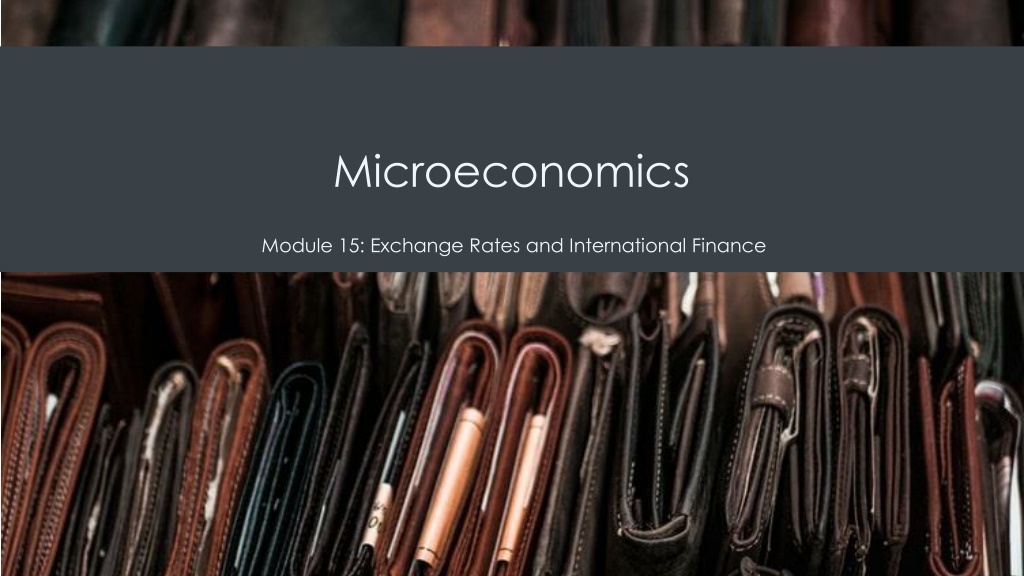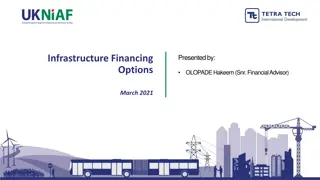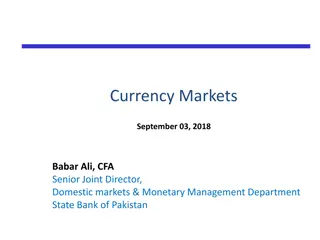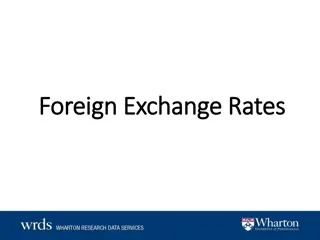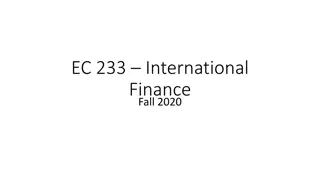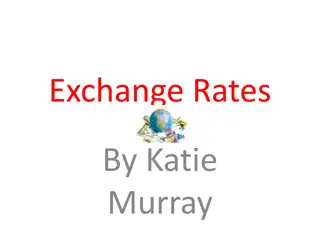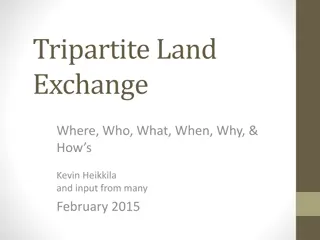Understanding Exchange Rates and International Finance
Exchange rates play a crucial role in global economics, impacting the value of currencies and influencing international trade and investments. Strong or weak dollar values have significant implications, affecting businesses, travelers, and investors. The foreign exchange market is vast, with daily trades amounting to trillions of dollars. Factors such as supply and demand, foreign investments, and trade activities drive currency fluctuations, making it essential to comprehend international finance dynamics.
Download Presentation

Please find below an Image/Link to download the presentation.
The content on the website is provided AS IS for your information and personal use only. It may not be sold, licensed, or shared on other websites without obtaining consent from the author. Download presentation by click this link. If you encounter any issues during the download, it is possible that the publisher has removed the file from their server.
E N D
Presentation Transcript
Microeconomics Module 15: Exchange Rates and International Finance
Why It Matters: Exchange Rates and International Finance Exchange Rates: the price of one currency expressed in terms of units of another currency What does it mean to have a strong or weak dollar? What are the implications of fluctuations in exchange rates? An exchange rate is a price that is, the price of one currency in terms of another currency and so we can analyze it with the tools of supply and demand.
The Foreign Exchange Market Most countries have their own currencies, but not all Sometimes small economies use the currency of an economically larger neighbor Ecuador, El Salvador, Panama all use the U.S. dollar Dollarize means to use the U.S. dollar as their currency Sometimes nations share a common currency, such as the Euro The market in which people or firms use one currency to purchase another currency is called the foreign exchange market Every exchange rate is a price the price of one currency expressed in terms of units of another currency The key framework for analyzing prices is supply and demand
The Extraordinary Size of the Foreign Markets Table 1. Currencies Traded Most on Foreign Exchange Markets as of April, 2016 The quantities traded in foreign exchange markets are breathtaking A survey done in April, 2013 by the Bank of International Settlements found that $5.3 trillion per day was traded on foreign exchange markets This makes the foreign exchange market the largest market in the world economy In contrast, 2013 U.S. real GDP was $15.8 trillion per year Currency % Daily Share U.S. dollar 87.6% Euro 31.3% Japanese yen 21.6% British pound 12.8% Australian dollar 6.9% Canadian dollar 5.1% Swiss franc 4.8% Chinese yuan 2.6% (Source: http://www.bis.org/publ/rpfx16fx.pdf)
International Supply and Demand The demand for dollars comes from U.S. export firms seeking to convert their earnings in foreign currency back into U.S. dollars foreign tourists converting their earnings in a foreign currency back into U.S. dollars foreign investors seeking to make financial investments in the U.S. economy. On the supply side of the foreign exchange market for the trading of U.S. dollars are foreign firms that have sold imports in the U.S. economy and are seeking to convert their earnings back to their home currency U.S. tourists abroad U.S. investors seeking to make financial investments in foreign economies.
Demanders and Suppliers of Currency in Foreign Exchange Markets Financial investments that cross international boundaries, and require exchanging currency, are often divided into two categories Foreign Direct Investment (FDI): purchasing more than ten percent of a firm or starting a new enterprise in another country Portfolio Investment: an investment in another country that is purely financial and does not involve any management responsibility
Demand and Supply Line-ups Table 2. The Demand and Supply Line-ups in Foreign Exchange Markets Demand for the U.S. Dollar Comes from Supply of the U.S. Dollar Comes from A foreign firm that has sold imported goods in the United States, earned U.S. dollars, and is trying to pay expenses incurred in its home country A U.S. exporting firm that earned foreign currency and is trying to pay U.S.-based expenses Foreign tourists visiting the United States U.S. tourists leaving to visit other countries Foreign investors who wish to make direct investments in the U.S. economy U.S. investors who want to make foreign direct investments in other countries Foreign investors who wish to make portfolio investments in the U.S. economy U.S. investors who want to make portfolio investments in other countries
Participants in the Exchange Rate Market The foreign exchange market does not involve the ultimate suppliers and demanders of foreign exchange literally seeking each other out The foreign exchange market works through financial institutions, and it operates on several levels Most people and firms who are exchanging a substantial quantity of currency go to a bank Most banks provide foreign exchange as a service to customers These banks (and a few other firms), known as dealers, then trade the foreign exchange This is called the interbank market
Strengthening and Weakening Currency When the value of a currency rises the exchange rate is described as appreciating or strengthening When the value of a currency falls, the exchange rate is described as depreciating or weakening In looking at the exchange rate between two currencies, the appreciation or strengthening of one currency must mean the depreciation or weakening of the other
Strengthening and Weakening Currency (cont.) With the price of a typical good or service, it is clear that higher prices benefit sellers and hurt buyers, while lower prices benefit buyers and hurt sellers In the case of exchange rates, it is useful to trace through how different participants in the market will be affected by a stronger or weaker currency For a U.S. tourist abroad, who is exchanging U.S. dollars for foreign currency as necessary, a stronger U.S. dollar is a benefit A stronger dollar injures the prospects of a U.S. financial investor who has already invested money in another country a stronger U.S. dollar boosts the returns of a foreign investor putting money into a U.S. investment
How Do Exchange Rate Movements Affect Each Group Interested Party Reaction to Stronger U.S. Dollar Reaction to Weaker U.S. Dollar U.S. Exporting Firm Negative Positive Foreign firm exporting to the U.S. Positive Negative U.S. tourist abroad Positive Negative Foreign tourist in the U.S. Negative Positive U.S. investor abroad Negative Positive Foreign investor in the U.S. Positive Negative
Demand and Supply Shifts in Foreign Exchange Markets The foreign exchange market involves firms, households, and investors who demand and supply currencies coming together through their banks and the key foreign exchange dealers
Expectations about Future Exchange Rates One reason to demand a currency on the foreign exchange market is the belief that the value of the currency is about to increase One reason to supply a currency is the expectation that the value of the currency is about to decline In the foreign exchange market, supply and demand typically both move at the same time Groups of participants in the foreign exchange market like firms and investors include some who are buyers and some who are sellers An expectation of a future shift in the exchange rate affects both buyers and sellers that is, it affects both demand and supply for a currency
Differences across Countries in Rates of Return The motivation for investment, whether domestic or foreign, is to earn a return If rates of return in a country look relatively high, then that country will tend to attract funds from abroad Conversely, if rates of return in a country look relatively low, then funds will tend to flee to other economies Changes in the expected rate of return will shift demand and supply for a currency Since a nation s central bank can use monetary policy to affect its interest rates, a central bank can also cause changes in exchange rates
Relative Inflation If a country experiences a relatively high inflation rate compared with other economies, then the buying power of its currency is eroding This tends to discourage anyone from wanting to acquire or to hold the currency The graph shows an example based on an actual episode concerning the Mexican peso
Purchasing Power Parity Arbitrage: the process of buying a good and selling goods across borders to take advantage of international price differences Purchasing Power Parity (PPP): the exchange rate that equalized the prices of internationally traded goods across countries One reason to demand a currency on the foreign exchange market is the belief that the value of the currency is about to increase The purchasing power parity exchange rate has two functions: PPP exchange rates are often used for international comparison of GDP and other economic statistics Exchanges rates will often get closer and closer to it as time passes
Exchange Rates, Aggregate Demand, and Aggregate Supply A central bank will be concerned about the exchange rate for three reasons: 1. Movements in the exchange rate will affect the quantity of aggregate demand in an economy 2. Frequent substantial fluctuations in the exchange rate can disrupt international trade and cause problems in a nation s banking system 3. The exchange rate may contribute to an unsustainable balance of trade and large inflows of international financial capital Foreign trade in goods and services typically involves incurring the costs of production in one currency while receiving revenues from sales in another currency
Fluctuations in Exchange Rates Exchange rates can fluctuate a great deal in the short run One of the most economically destructive effects of exchange rate fluctuations can happen through the banking system This process of borrowing in a foreign currency and lending in a domestic currency can work just fine, as long as the exchange rate does not shift
Exchange-Rate Policies Nations need to think about what exchange rate policy they should adopt Exchange rate policies come in a range of different forms
Floating Exchange Rates A policy which allows the foreign exchange market to set exchange rates is referred to as a floating exchange rate The U.S. dollar is a floating exchange rate, as are the currencies of about 40% of the countries in the world economy Movements of floating exchange rates have advantages All prices of goods and services rise and fall throughout a market economy, as demand and supply shift
Using Soft Pegs and Hard Pegs A government intervenes in the foreign exchange market when the exchange rate of its currency is different from what the market would have produced This is establishes a peg A soft peg is the name for an exchange rate policy where the government usually allows the exchange rate to be set by the market If the exchange rate seems to be moving rapidly in one direction, the central bank will intervene in the market With a hard peg exchange rate policy, the central bank sets a fixed and unchanging value for the exchange rate A central bank can implement soft peg and hard peg policies
Tradeoffs of Soft Pegs and Hard Pegs When a country decides to alter the market exchange rate, it faces a number of tradeoffs One concern with pegged exchange rate policies is that they imply a country s monetary policy is no longer focused on controlling inflation or shortening recessions Another issue arises when a central bank intervenes directly in the exchange rate market A central bank that causes a large increase in the supply of money is also risking an inflationary surge in aggregate demand Another issue is that when a government pegs its exchange rate, it may unintentionally create another reason for additional fluctuation
A Merged Currency Merged currency- a common currency shared with one or more nations A merged currency approach eliminates foreign exchange risk altogether A merged currency also poses problems A merged currency means that a nation has given up altogether on domestic monetary policy, and instead has put its interest rate policies in other hands There is no consensus among economists about which exchange rate policies are best: floating, soft peg, hard peg, or merged currencies
Quick Review What is the foreign exchange market and the main groups of people or firms who participate in the market? What are the different types of investments like foreign direct investment (FDI), portfolio investment? What is the exchange rate when a currency increases in value and a currency decreases in value? Who benefits from a stronger currency and who benefits from a weaker currency? What are the factors that cause the demand and supply of foreign currencies to shift? What is arbitrage and the importance of purchasing power parity?
More Quick Review How do the changes in exchange rates influence aggregate demand and supply? What is the difference among a floating exchange rate, a soft peg, a hard peg, and a merged currency? What are the tradeoffs that come with a floating exchange rate, a soft peg, a hard peg, and a merged currency?
